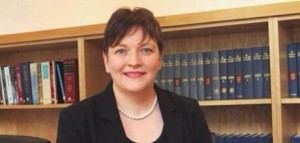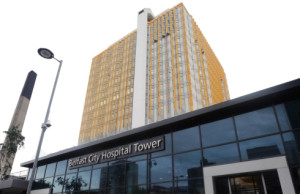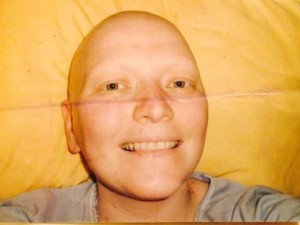We are delighted to share Nóirín O’Neill’s @Noirin0Neill story this week on Evidence-Based Nursing. Nóirín will be hosting this week’s #ebnjc twitter-chat on Wednesday 16th September (8-9pm UK time) on the Role of Expert Patients in Medicines Research and Development. To follow the chat on Twitter please use the #ebnjc
“One of the Most Fascinating Stories in the History of Medicine”
“The history of Acute Promyelocytic Leukaemia (APL) is one of the most fascinating stories in the history of medicine.” Dr. Francesco Lo-Coco, Professor of Haematology.
Dr. Leaft Hillestad first described APL in 1957. Dr. Hillestad identified APL as a distinctive subtype of AML and one that is aggressive and rapidly fatal if not correctly diagnosed and treated immediately. Further research was carried out by French and American scientists into the disease but it was Chinese scientists who made the revolutionary discovery that APL was responsive to ATRA, all trans-retinoic acid – a Vitamin A derivative. APL is a rare form of leukaemia that affects one in a million people in Europe. APL is a rapidly fatal aggressive haemorrhaging disease and early hemorrhagic death has to be avoided, ie., death within the first 30 days of diagnosis. Click here for further medical information.
Dr. Zhen-yi Wang was studying APL at Ruijin Hospital in Shanghai, along with Dr. Zhu Chen, and he believed that cancer cells could be converted into normal cells. Wang was inspired by the philosophical thinking of the famous Chinese philosopher Confucius who taught that there was a greater benefit to society if criminals were rehabilitated instead of punished. The drug ATRA causes leukaemic cells to abandon their relentless growth and mature into white blood cells. ATRA makes the leukemic cells “behave”. APL was transformed from a highly fatal disease to a highly curable disease. Zhen-yi Wang’s group introduced ATRA in treating APL in 1985, and APL patients like me have benefitted from his achievement. Morphologically, it is identified as the M3 subtype of acute myeloid leukemia by the French-American-British classification and cytogenetically is characterised by a balanced reciprocal translocation between chromosomes 15 and 17, which results in the fusion between promyelocytic leukaemia (PML) gene and retinoic acid receptor α (RARα).
At the time I became ill, I was 30 years old and studying a Masters Degree in Aberystwyth University in Wales in IT law and e-commerce. I previously studied law at Trinity College Dublin and qualified as a Solicitor with the Law Society of Ireland in 2001. However, nothing prepared me for the day that I was diagnosed with APL on 26th of November, 2004. I felt relatively normal up until about three days before I was diagnosed with APL. Symptoms included severe fatigue and nausea however it was the appearance of bruising on my legs, hands and chest areas, which triggered an emergency trip to the local GP.
The GP took a blood sample which was then taken by a family member directly to the laboratory at Withy Bush Hospital in Haverfordwest in Pembrokeshire, and within an hour, I was given the bad news that I had a very rare form of leukaemia called APL and the condition was life threatening. However, I was also given the good news that the disease is the most curable form of leukaemia in adults.
My platelet count was rock bottom when I was admitted to Cardiff University Hospital a couple of hours later. I wasn’t able to walk by the time I arrived at Cardiff University Hospital and I was getting severe cramps in my legs and thought I would die. I was pushed in a wheelchair through the corridors by the porter straight to Haematology where the team were waiting for me. It was an uphill battle to stay alive which was complicated by the fact that my veins were collapsing and peripheral venous access was proving difficult. The major risk was a cranial or pulmonary haemorrhage. We had to get my platelets to behave as quickly as possible. After two trips to theatre, an emergency central line was surgically inserted into the jugular vein in my neck. ATRA was initiated and aggressive blood product support commenced.
I enrolled on AML Clinical Trial 15 on the day I was diagnosed. This trial was to see if longer but less intensive chemotherapy regimen worked as well as standard chemotherapy for APL and to see if adding a drug called Gemtuzumab Ozogamicin (also known as Mylotarg) improved either treatment plan. Drugs included Daunorubicin and Cytarabine.
I spent approximately six weeks in Cardiff University Hospital and another five months in Belfast City Hospital, undergoing four aggressive intensive cycles of chemotherapy and blood product supportive treatment. Sometimes I had chemotherapy 23 out of 24 hours a day for five days in a row. Eventually, the central line in my neck was replaced in theatre with a Hickman line in Cardiff Hospital on Christmas Eve, 2004.
I had neutropenia after every cycle of chemotherapy and developed some very serious bacterial, viral and fungal infections such as RSV and the C.diff bug with fevers, chills, sweating, sores in the mouth, bleeding gums, skin ulcers and lots of other nasty symptoms like vomiting, severe abdominal cramps, nausea and blacking out. The final cycle of chemotherapy even triggered a bad attack of trigeminal neuralgia and an outbreak of cold sores. Intravenous (IV) prophylactic, antibacterial and antifungal antibiotics were administered regularly and blood cultures became the norm. The G-CSF growth factor was given to accelerate neutrophil recovery. Dietary measures were put in place and bedside physiotherapy was given for muscle wastage in my legs. Sometimes I could not eat for weeks and survived on nutritional shakes.
I had visits from the Palliative Care Team and Wound Relief Team and even the Cardiac Team when an infection in the heart was suspected. I was allowed home for a few days in between each cycle of chemotherapy, when the blood counts came up again. I had to avoid exposure to crowds and people with contagious illnesses especially children with viral infections. Temperature and hygiene were strictly monitored at home with the hospital providing a haematology helpline which became a lifeline. Painful bone marrow biopsies were carried out regularly for molecular monitoring of the disease and as part of the clinical trial. I didn’t require a bone marrow transplant and have not relapsed in the last ten years. Patients who have a relapse are usually treated with arsenic trioxide which I believe can induce a complete remission in 85% of patients.
How could my treatment have been improved? What could have been done better? I would not change anything about the treatment received or the nursing or medical staff in any of the three hospitals who looked after me. I received excellent professional support throughout my treatment from all of the haematology and nursing teams in both hospitals. They were all true professionals and it was a privilege to be under their care. When I thanked one of my Consultants Mr Jonathan Kell, Consultant Haematologist for saving my life, he said: “ Just three times”.
I have been in remission now for over ten years. I have since got married and have given birth to a baby daughter three years ago. My late father was a Gold Medalist pharmacist in Northern Ireland and I am now training to be an Expert Patient in the Medicines Research and Development with EUPATI @eupatients. I am also a member of the ASTERIX FP7 Patient Think Tank
Thanks to all of the following people for saving my life: The GP in Haverfordwest (name unknown); Dr. Grubb, Consultant Haematologist and his team at Withy Bush Hospital in Haverfordwest, Wales; Dr. Jonathan Kell, Consultant Haematologist and all of his team at University Hospital of Wales, Cardiff; Professor Mary Frances McMullen, Consultant Haematologist and all of her team at the Belfast City Hospital; Welsh Blood Service; Northern Ireland Blood Transfusion Service and all of the blood and platelet donors in Wales and Northern Ireland.
Nóirín O’Neill has spoken as an Expert Patient at many conferences to include NHS Confederation Annual Conference in Liverpool (2015); Northern Ireland Blood Transfusion Services Gold Badge Awards Function (2015); Northern Ireland Rare Diseases Partnership Annual Conference (2015); Northern Ireland e-Health Conference (2014); Northern Ireland’s first Healthcare Social Media Conference (2014); Nóirín also attended the EFGCP annual conference in Brussels in 2015.
Nóirín O’Neill (@Noirin0Neill) will host a Twitter Chat on the “Role of Expert Patients in Medicines Research and Development” on Wednesday 16th September, 2015 at 8.00 pm (CET) Use the hashtag #ebnjc
Tweetchat Questions:
- Have rare disease patients a role to play in the education of medical providers?
- What role do you think Expert Patients should have in Medicines Research and Development?
- What challenges do you think Expert Patients in Medicines Research and Development face?
- What impact do you think working with Expert Patients in Medicines Research and Development could have on your future work?


